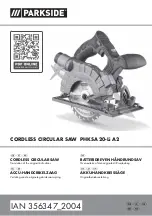
-30-
W1761/W1762 12" Table Saw with Riving Knife
O
PE
R
AT
IO
N
S
Non-Through &
Through Cuts
Non-Through Cuts
A non-through cut is a sawing operation where
the blade does not protrude above the top
face of the wood stock. Since non-through cuts
require the removal of the blade guard and
splitter, the riving knife must be installed. Dado
cuts, rabbet cuts, and resawing operations are
non-through cuts that can be performed with
this table saw.
Non-through cuts have a higher risk of injury
from kickback because the splitter and blade
guard must be removed. Kickback is an event in
which the workpiece is propelled back towards
the operator at a high rate of speed. Always
remember to re-install the blade guard and
splitter after performing a non-through cut.
Through Cuts
A through cut is a sawing operation in which the
workpiece is completely sawn through. Ripping,
crosscutting, miter cuts, and angled cuts are all
through cutting operations. The blade guard and
splitter or riving knife must be installed during
through cuts.
Through cuts have a risk of kickback. Read,
understand, and follow instructions and safety
precautions for each type of cut to reduce the
risk of injury.
Safety precautions and instructions for each
type of cut are located on the following
pages:
1.
Ripping:
Page 31
2.
Crosscutting:
Page 32
3.
Miter Cuts:
Page 33
4.
Blade Tilt & Bevel Cuts:
Page 33
5.
Dado Cutting:
Page 34
6.
Rabbet Cutting:
Page 36
7.
Resawing:
Page 38
Workpiece Inspection
Some workpieces are not safe to cut or may
require modification before they can be made
safe to cut.
Before cutting, get in the habit of inspecting all
workpieces for the following
:
•
Foreign Objects
: Nails, staples, dirt, rocks
and other foreign objects are often embed-
ded in wood. While cutting, these objects
can become dislodged and hit the opera-
tor, they can cause kickback, and they
can break or chip the blade, which might
then fly apart. Always visually inspect your
workpiece for these items. If they can't be
removed, do NOT cut the workpiece.
•
Large/Loose Knots
: Loose knots can become
dislodged during the cutting operation. Large
knots can cause kickback and machine dam-
age. Choose workpieces that do not have
large/loose knots or plan ahead to avoid
cutting through them.
•
Wet or "Green" Stock
: Cutting wood with a
moisture content over 20% causes unneces-
sary wear on the blades, increases the risk
of kickback, and yields poor results.
•
Excessive Warping
: Workpieces with exces-
sive cupping, bowing, or twisting are dan-
gerous to cut because they are unstable and
often unpredictable when being cut. DO NOT
use workpieces with these characteristics!
•
Minor Warping
: Workpieces with slight cup-
ping can be safely supported if the cupped
side is facing the table or the fence. On
the contrary, a workpiece supported on the
bowed side will rock during a cut and could
cause kickback or severe injury.
Summary of Contents for W1761
Page 14: ......
Page 17: ...3 W1761 W1762 12 Table Saw with Riving Knife INTRODUCTION...
Page 18: ...4 W1761 W1762 12 Table Saw with Riving Knife INTRODUCTION...
Page 77: ...63 W1761 W1762 12 Table Saw with Riving Knife PARTS Main Table Motor Cabinet...
Page 83: ......
Page 84: ......
Page 87: ......
Page 88: ......
















































